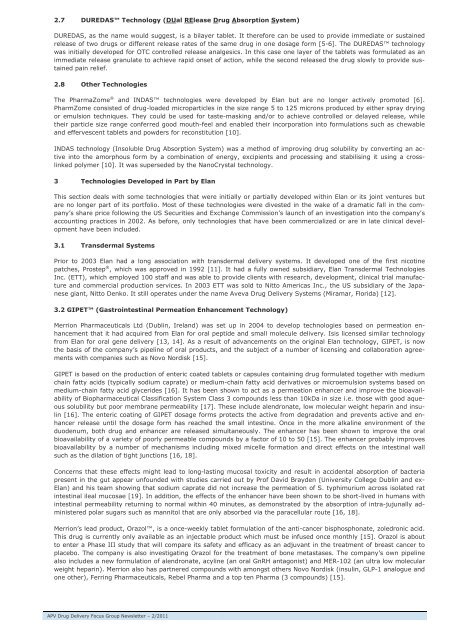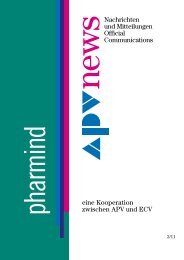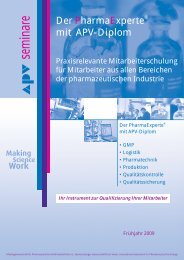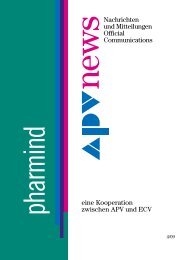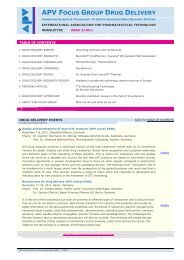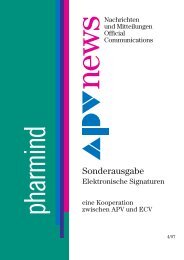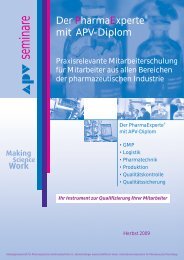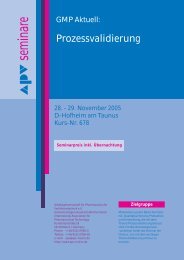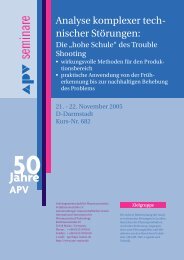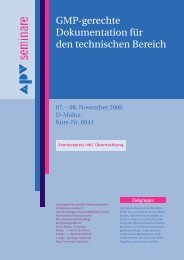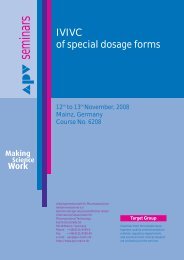APV FOCUS GROUP DRUG DELIVERY
APV FOCUS GROUP DRUG DELIVERY
APV FOCUS GROUP DRUG DELIVERY
Create successful ePaper yourself
Turn your PDF publications into a flip-book with our unique Google optimized e-Paper software.
2.7 DUREDAS Technology (DUal RElease Drug Absorption System)<br />
DUREDAS, as the name would suggest, is a bilayer tablet. It therefore can be used to provide immediate or sustained<br />
release of two drugs or different release rates of the same drug in one dosage form [5-6]. The DUREDAS technology<br />
was initially developed for OTC controlled release analgesics. In this case one layer of the tablets was formulated as an<br />
immediate release granulate to achieve rapid onset of action, while the second released the drug slowly to provide sustained<br />
pain relief.<br />
2.8 Other Technologies<br />
The PharmaZome ® and INDAS technologies were developed by Elan but are no longer actively promoted [6].<br />
PharmZome consisted of drug-loaded microparticles in the size range 5 to 125 microns produced by either spray drying<br />
or emulsion techniques. They could be used for taste-masking and/or to achieve controlled or delayed release, while<br />
their particle size range conferred good mouth-feel and enabled their incorporation into formulations such as chewable<br />
and effervescent tablets and powders for reconstitution [10].<br />
INDAS technology (Insoluble Drug Absorption System) was a method of improving drug solubility by converting an active<br />
into the amorphous form by a combination of energy, excipients and processing and stabilising it using a crosslinked<br />
polymer [10]. It was superseded by the NanoCrystal technology.<br />
3 Technologies Developed in Part by Elan<br />
This section deals with some technologies that were initially or partially developed within Elan or its joint ventures but<br />
are no longer part of its portfolio. Most of these technologies were divested in the wake of a dramatic fall in the company’s<br />
share price following the US Securities and Exchange Commission’s launch of an investigation into the company's<br />
accounting practices in 2002. As before, only technologies that have been commercialized or are in late clinical development<br />
have been included.<br />
3.1 Transdermal Systems<br />
Prior to 2003 Elan had a long association with transdermal delivery systems. It developed one of the first nicotine<br />
patches, Prostep ® , which was approved in 1992 [11]. It had a fully owned subsidiary, Elan Transdermal Technologies<br />
Inc. (ETT), which employed 100 staff and was able to provide clients with research, development, clinical trial manufacture<br />
and commercial production services. In 2003 ETT was sold to Nitto Americas Inc., the US subsidiary of the Japanese<br />
giant, Nitto Denko. It still operates under the name Aveva Drug Delivery Systems (Miramar, Florida) [12].<br />
3.2 GIPET (Gastrointestinal Permeation Enhancement Technology)<br />
Merrion Pharmaceuticals Ltd (Dublin, Ireland) was set up in 2004 to develop technologies based on permeation enhancement<br />
that it had acquired from Elan for oral peptide and small molecule delivery. Isis licensed similar technology<br />
from Elan for oral gene delivery [13, 14]. As a result of advancements on the original Elan technology, GIPET, is now<br />
the basis of the company’s pipeline of oral products, and the subject of a number of licensing and collaboration agreements<br />
with companies such as Novo Nordisk [15].<br />
GIPET is based on the production of enteric coated tablets or capsules containing drug formulated together with medium<br />
chain fatty acids (typically sodium caprate) or medium-chain fatty acid derivatives or microemulsion systems based on<br />
medium-chain fatty acid glycerides [16]. It has been shown to act as a permeation enhancer and improve the bioavailability<br />
of Biopharmaceutical Classification System Class 3 compounds less than 10kDa in size i.e. those with good aqueous<br />
solubility but poor membrane permeability [17]. These include alendronate, low molecular weight heparin and insulin<br />
[16]. The enteric coating of GIPET dosage forms protects the active from degradation and prevents active and enhancer<br />
release until the dosage form has reached the small intestine. Once in the more alkaline environment of the<br />
duodenum, both drug and enhancer are released simultaneously. The enhancer has been shown to improve the oral<br />
bioavailability of a variety of poorly permeable compounds by a factor of 10 to 50 [15]. The enhancer probably improves<br />
bioavailability by a number of mechanisms including mixed micelle formation and direct effects on the intestinal wall<br />
such as the dilation of tight junctions [16, 18].<br />
Concerns that these effects might lead to long-lasting mucosal toxicity and result in accidental absorption of bacteria<br />
present in the gut appear unfounded with studies carried out by Prof David Brayden (University College Dublin and ex-<br />
Elan) and his team showing that sodium caprate did not increase the permeation of S. typhimurium across isolated rat<br />
intestinal ileal mucosae [19]. In addition, the effects of the enhancer have been shown to be short-lived in humans with<br />
intestinal permeability returning to normal within 40 minutes, as demonstrated by the absorption of intra-jujunally administered<br />
polar sugars such as mannitol that are only absorbed via the paracellular route [16, 18].<br />
Merrion’s lead product, Orazol, is a once-weekly tablet formulation of the anti-cancer bisphosphonate, zoledronic acid.<br />
This drug is currently only available as an injectable product which must be infused once monthly [15]. Orazol is about<br />
to enter a Phase III study that will compare its safety and efficacy as an adjuvant in the treatment of breast cancer to<br />
placebo. The company is also investigating Orazol for the treatment of bone metastases. The company’s own pipeline<br />
also includes a new formulation of alendronate, acyline (an oral GnRH antagonist) and MER-102 (an ultra low molecular<br />
weight heparin). Merrion also has partnered compounds with amongst others Novo Nordisk (insulin, GLP-1 analogue and<br />
one other), Ferring Pharmaceuticals, Rebel Pharma and a top ten Pharma (3 compounds) [15].<br />
<strong>APV</strong> Drug Delivery Focus Group Newsletter – 2/2011 Page 10 of 15


